Fuzzy logic and Satellite communication Systems
- 1. Fuzzy logic in Satellite communication Systems Samad Razaghzadeh Shabestari Telecommunication Research Lab. 3/31/2010
- 2. Outline ’üĄ Satellite Communication Systems ’üĄ SLAs (System Level Agreements) ’üĄ QoS (Quality of Service) ’üĄ Problem Space ’üĄ Fuzzy Logic Controller ’üĄ Motivation ’üĄ RED-FL Algorithm ’üĄ Control problems ’üĄ Conclusion
- 3. Introduction ’üĄ Satellite networks play a significant and major role in numerous fields. ’üĄ Four major growth in telecommunications marketing areas are: 1. messaging and navigation services (wireless and satellite), 2. mobility services (wireless and satellite), 3. video delivery services (cable and satellite), 4. interactive multimedia services (fibre/cable, satellite). ’üĄ Vast marketing opportunity with coupling satellite characteristics and terrestrial networks 1. Wide area coverage (extensive geographic reach) 2. Multicast capabilities
- 4. The Architecture of Satellite-Based IP Network ’üĄ Satellite relays signals among ground terminals and between the hub gateway(HG) and ground terminals(GT). ’üĄ All GTs communicate only with the HG, and vice versa. ’üĄ HG dynamically allocates Upload and Download link Bws to GTs according to SLAs and conditions such as the systems resources availability and weather conditions. ’üĄ HG executes QoS control link congestion avoidance and system operation, administration, maintenance and provisioning. ’üĄ GTs allocate BW to users connected to it within the available link capacity assigned to it by HG. ’üĄ LANs, servers and workstations may connect to the systems through HG and GTs.
- 5. Example: Private IP networks iDIRECT Technologies Co. - 3DES Link Encryption Security
- 6. Major drawbacks of satellite communications ’üĄ High propagation delay due to their altitude: Impact on the Quality of Service (QoS) to the end users ’üĄ SNR(Signal to Noise Ratio): Affect the data transmission done through the satellite ’üĄ Bandwidths associated with satellite systems : Be a scare resource compared to terrestrial systems ’üĄ Dynamic weather conditions: may affect severely overall performance of satellite communications and result channel fading or degradation. ’üĄ Channel fading or degradation most often leads to network congestion. ’üĄ Congestion control : significant issue in satellite networks due to the inherent large channel latency (delay) or high bandwidth-delay product. ’üĄ the network congestion control :critical in broadband satellite-IP based networks, for committing to the Service-Level-Agreement (SLA) with regard to Quality-Of-Service (QoS).
- 7. Theoretical Background-SLAs ’üĄ SLAs stands for Service Level Agreements ’üĄ To provide predictable and reliable services, service providers of communication services negotiate Service Level Agreement with the customers. ’üĄ The purpose of SLAs is to identify the shared objectives between the service providers and the customers ’üĄ Example: - Service Provider ŌĆō ŌĆ£We agree to provide you this particular level of service based on agreed-to set of guidelinesŌĆØ - Customer ŌĆō ŌĆ£We agree to abide by your guidelines in anticipation that you provide us this agreed level of serviceŌĆØ ’üĄ The most important agreements between service provider and customer (User) : 1. Availability of the promised level of service to the user 2. Performance measures of various components of the userŌƤs workload 3. Bounds of guaranteed performance and availability 4. Cost of the service provided to the customer ’üĄ More specific parts of an SLA are service level specification (SLS), traffic conditioning agreement (TCA), and traffic conditioning specification (TCS).
- 8. Theoretical Background-QoS ’üĄ Service providers define the ŌĆ£Quality of ServiceŌĆØ (QoS) a customer can expect in the Service Level Agreements. ’üĄ Quality of Service is defined by IETF (Internet Engineering Task Force ) as ŌĆ£ A set of service requirements to be met by the network while transporting a flow. ’üĄ Quality of Service is one of the most important performance measures of any communication service.
- 9. QoS (Continued) ’üĄ Qos in packet switched networks is expressed by the following set of parameters to meet the requirements defined in SLAs: 1. Packet loss rate: Occur when there is congestion in the transmission channel and these channels are forced to drop the packets since it is almost impossible to transfer them any forward to their destination nodes. 2. Jitter (Variation of latency): Jitter variations in the IP packet transfer delay. 3. Queuing delay: Experienced by packets while passing through the network. ’üĄ Latency or Queuing delay is very low whenever the networks are free of congestion. However; when congestion starts to build up in the channel, the packets are forced to wait so latency can be very high.
- 10. QoS (Continued) ’üĄ Three major categories of approaches to ensure end-to-end QoS: 1. Integrated Services(IntServ) Suitable for small scale work and not very popular. 2. Differentiated Services(DiffServ) difficult to predict end-to-end behaviour. impossible to sell different classes of end-to-end connectivity to end users, as one provider's highest-priority packet may be anotherŌĆ×s low priority. only works if the boundary hosts honour the policy agreed upon. 3. Active Queue Management (AQM) ’üČ The first two are based on flows distinction but AQM can fairly regulate network traffic w/o flows traffic.
- 11. QoS-AQM ’üĄ A packet dropping/making mechanism for router queue management. ’üĄ Targets to reduce the average queue length and thus decrease the packet delay. ’üĄ Common in best effort networks where all streams have the same network access right. ’üĄ A technique of preventing congestion in packet- switched networks.
- 12. RED(Random Early Detection) ’üĄ One of the most well-known AQMs ’üĄ An efficient queue management and congestion avoidance algorithm by controlling the average queue length in a reasonable range and dropping packets based on statistical probabilities. ’üĄ Proven to be stable [4] but its performance is sensitive to tune the parameters dynamically ’üĄ Sets the min.Threshold(qmin ) And max.Threshold(qmax ) for queues and handle newly arrived packets according the following rules:
- 13. RED (continued) ’üĄ IF qmin Ōēż queue length Ōēż qmax , THEN RED drops newly arrived packets will be dicarded with a drop probability ’üĄ IF queue length>qmax , THEN RED drops all newly arrived packets. ’üĄ IF queue length<qmin , THEN no packet dropping.
- 14. Problem Space ’üĄ Designing rules to maintain the SLAs for sat. Based Networks are more complex than non-sat. networks since predictability of service in sat networks and performance of QoS are effected by external factors like weather condition. ’üĄ Thus channel fades and communication between HB and GT cannot be maintained due to the incapability of the ground terminal to properly predict and react to the rain fade situations on its own. ’üĄ In addition, the hub does not have any intelligence to assist the ground terminals during rain fade situations. ’üĄ It is extremely difficult to clearly engineer SLA metrics such as throughput, delay and jitter when there are uncertainties. ’üĄ Therefore, there is an inherent fuzziness in the Sat. Based network congestion control .
- 15. Motivation ’üĄ Some of the very well known advantages of fuzzy logic control: 1. Easy handling of inherent nonlinearities 2. Easy handling of multiple input signals 3. Less dependence on availability of precise mathematical models ’üĄ Fuzzy control techniques are suitable to apply to the congestion control problems in satellite networks due to: 1. The inherent difficulty in obtaining precise mathematical models through conventional analytical methods. 1. Possibility to obtain simple linguistic rule curves for congestion control.
- 16. Intelligent systems-Fuzzy Logic ’üĄ The general fuzzy rule is in the form of If A is x Then B is y ’üĄ ŌĆ×xŌƤ is a fuzzy set of the input variable A and ŌĆ×yŌƤ is the fuzzy set of the output variable B. ’üĄ ŌĆ×max-minŌƤ operators are used for implication and composition respectively in Mamdani inference systems. ’üĄ Triangular membership functions were used as proven to be extremely effective in networks [3]
- 17. Design of the Fuzzy logic controller (Fuzzy Inference system) -Fuzzifier: Crisp values are transformed for linguistic terms of fuzzy sets. - Knowledge Base (Fuzzy Rule Base) :IF-THEN rules to characterize the goals and policies of the problem considered. -Fuzzy Inference Engine : ŌĆó Provide the decision-making logic to the system. ŌĆó Respond to fuzzy input provided by Fuzzifier and also possibly previous inference from the rule-base itself ŌĆóIdentify one or more possible control action -Defuzzifier : Central method
- 18. Functional block diagram for the high-level system design- case study ’üĄ Hub Correlator ŌłÆ Correlate relevant precipitation data with fuzzy inference engine to predict service degradation within specific timeframe ŌłÆ Initiate appropriate proactive or reactive required actions ’üĄ Link Detector ŌłÆ Assign traffic on forward and return link timeslots ŌłÆ Adapted to fade & congestion ’üĄ QoS Arbitrator ŌłÆ Active queue management to discard packets/flows and notify impending network congestion ’üĄ Traffic Shaper ŌłÆ Connection admission control ŌłÆ Packet conditioning and scheduling The motivation of the design is to achieve high performance communications and congestion adaptation to impacts of dynamically weather change, on system performance (SLA QoS), e.g., channel rain-fade.
- 19. RED-Fuzzy logic ’üĄ A novel Fuzzy-based packet dropping algorithm ’üĄ In [1] fuzzy inference systems applied to RED for parameter tuning, based on the inherent fuzziness in network congestion. ’üĄ Making satellite-IP based network more adaptive to dynamic weather condition change, e.g., channel rain-fade(rain attenuation) ’üĄ In [2] tried to control complexity and non- linearity inherent of satellite systems by coupling FL and RED to prevent impending congestion from happening and to maintain QoS.
- 20. Control problem scenarios [1]: ’üĄ Three different scenarios (control problem) for weather adaption are considered: 1. Adjustment of the Bandwidth 2. Adjustment of the minimum queue length qmin 3. Adjustment of the maximum queue length qmax ’üĄ The current weather conditions, allocated bandwidth and the queue length are the input parameters to the above control problems.
- 21. The universe discourse for input and output parameters 1) Bandwidth range (input in scenario #1) is selected to vary between 16 and 128 kbps per user. The packet size is fixed at 512 bytes. 2) The minimum queue length qmin (input in scenario #2) is varied between 4 and 16 packets. 3) The maximum queue length qmax (input in scenario #3) is varied between 8 and 20 packets. 4) Current weather condition (input in all cases) is based on the total precipitation rate. 5) The bandwidth adjustment (output in scenario #1) is done between 0 and 48 kbps per user. 6) The output parameters in scenarios #2 and #3 are adjusted to fall within the ranges already mentioned under 2) and 3).
- 22. Fuzzy sets associated with input parameters The synthesis of the membership functions depend on the choice of thresholds of the weather condition parameters, e.g., the amount of precipitation. Change in weather conditions (mm o rain drops/hour)
- 23. Scenario#1 (bandwidth ranges ) Bandwidth range (input in scenario #1) is selected to vary between 16 and 128 kbps per user. The packet size is fixed at 512 bytes. Scenario # 1 [Bandwidth Adjustment] ŌłÆ IF (the current allocated bandwidth is low) AND (weather becomes worse) THEN {heavily increase the bandwidth to commit the SLA QoS}; ŌłÆ IF (the current allocated bandwidth is medium) AND (weather becomes worse) THEN {slightly increase bandwidth to commit the SLA QoS}; ŌłÆ IF (the current allocated bandwidth is high) AND (weather becomes worse) THEN {do not change bandwidth}; ŌĆ”ŌĆ”ŌĆ”..
- 24. Scenario#2(Ranges of qmin) The minimum queue length qmin (input in scenario #2) is varied between 4 and 16 packets.
- 25. Scenario#3(Ranges of qmax) The maximum queue length qmax (input in scenario #3) is varied between 8 and 20 packets.
- 26. Fuzzy sets associated with output parameters
- 27. Fuzzy sets associated with output parameters Defuzzification converts the output fuzzy result into a crisp and a singular output. Center of area method is used as the defuzzification method.
- 28. Control Problem-scenarios [2] ’üĄ eliminating the fixed threshold value, specifically the qmax value and the drop probability value from RED and replace with dynamic network state dependant values calculated by the FI engine. ’üĄ Inference engine keep dynamically calculating qmax and drop prob. Behaviour based on 2 following network state inputs: 1. Link Capacity of the channel between the gateway and the destination (Relay Satellite ) 2. The number of dynamic traffic sources accessing the gateway : It has a direct impact on changing queue sizes and provides a direct measure of the future queue state.
- 29. Input ŌĆōlink capacity: 1.8 MB assumed to belong to fuzzy set High 0.18 MB assumed to belong to fuzzy set Med 0.16 MB assumed to belong to fuzzy set Low
- 30. Input ŌĆō Number of traffic sources: 90 Sources assumed to belong to fuzzy set High 60 Sources assumed to belong to fuzzy set Med 20 Sources assumed to belong to fuzzy set Low
- 31. Fuzzy sets associated with output parameters
- 32. Rule -1 is read by the inference engine as ŌĆ£IF Link Capacity is low AND Number of Traffic Sources is low THEN qmax is medium and p-drop is medium.ŌĆØ
- 33. Conclusion ’üĄIntelligent network congestion control mechanisms are highly expected for Satellite IP-based networks due to the inherent impacts of dynamical weather change on system performance, e.g., channel rain-fading. ’üĄnovel Fuzzy-based packet dropping algorithm may satisfy the SLAs and QoS requirements under dynamic weather conditions. ’üĄIt needs to be tested in the real world field work and on the real time satellite hub/terminal gateways. ’üĄ Simulations have been done in single Hub-Terminal connection . ’üĄResearch on multiple terminal gateway connections would be interested.
- 34. References: ’üĄ [1]:Adaptive Congestion Control Under dynamic weather condition for Wireless and Satellite Networks;Hongqing Zeng, Anand Srinivasan, Brian Cheng, and Changcheng Huang; EION Inc., Carleton University; ITC2007-PP.92-107 ’üĄ [2]:Congestion Control for Adaptive Satellite Communication systems Using Intelligent Systems;Banupriya Vallamsundar, Jiesheng Zhu,Brian Cheng; University of Waterloo; Carleton University; Signals, systems and Electronic, 2007,ISEE07 International Symposium-pp.415-418 ’üĄ [3]: Design an active queue management algorithm based on fuzzy logic decision.; Fan, Y., Ren, F., Lin, C.; Proceedings of IEEE ICCT 2003, ’üĄ [4]: Steady state analysis of the RED gateway: stability, transient behavior, and parameter setting, H. Ohsaki, M. Murata, and H. Miyahara, IEICE Transactions on Communications, Vol. E85-B, Jan. 2002
- 36. Back up ’üĄ The term ŌĆ£serviceŌĆØ in the telecommunications: A service in an IP based environment is defined by International Telecommunications Unit (ITU) as ŌĆ£a service provided by the service plan to an end user (e.g., a host [end system] or a network element) and which utilizes the IP transfer capabilities and associated control and management functions, for delivery of the user information specified by the service level agreementsŌĆØ (ITU Recommendations, 2001). ’üĄ The meaning of ŌĆ£qualityŌĆØ is very broad: In telecommunications it is commonly used in assessing whether the service satisfies the userŌƤs expectations. However, the evaluation depends on various criteria related to the party rating the service. Customers assess it on the basis of a personal impression and in comparison to their expectations, while an engineer expresses quality in terms of technical parameters. This discrepancy may sometimes lead to misunderstandings between the service provider and the customer.


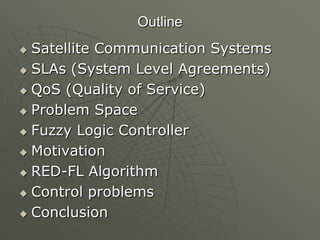
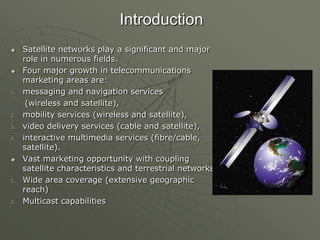

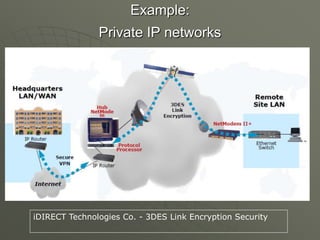
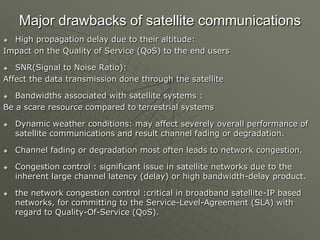
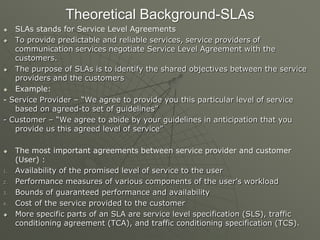

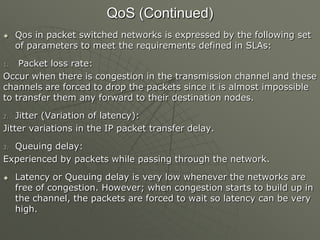
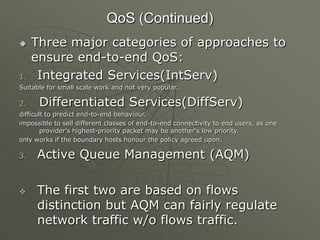
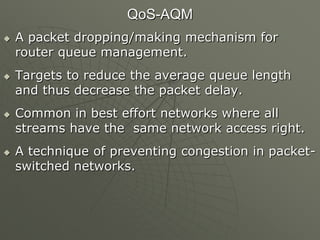
![RED(Random Early Detection)
’üĄ One of the most well-known AQMs
’üĄ An efficient queue management and congestion
avoidance algorithm by controlling the average queue
length in a reasonable range and dropping packets
based on statistical probabilities.
’üĄ Proven to be stable [4] but its performance is sensitive
to tune the parameters dynamically
’üĄ Sets the min.Threshold(qmin ) And max.Threshold(qmax )
for queues and handle newly arrived packets according
the following rules:](https://image.slidesharecdn.com/eabf64d9-e16a-4180-8909-1aa4b48aff60-160702174139/85/Fuzzy-logic-and-Satellite-communication-Systems-12-320.jpg)
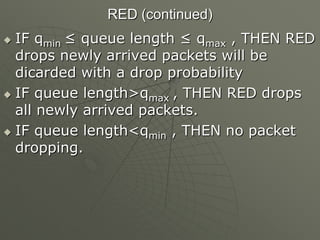

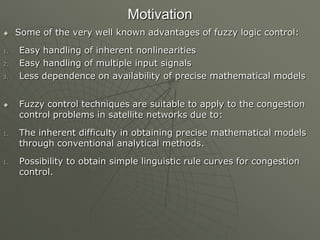
![Intelligent systems-Fuzzy Logic
’üĄ The general fuzzy rule is in the form of
If A is x Then B is y
’üĄ ŌĆ×xŌƤ is a fuzzy set of the input variable A and ŌĆ×yŌƤ is
the fuzzy set of the output variable B.
’üĄ ŌĆ×max-minŌƤ operators are used for implication and
composition respectively in Mamdani inference
systems.
’üĄ Triangular membership functions were used as
proven to be extremely effective in networks [3]](https://image.slidesharecdn.com/eabf64d9-e16a-4180-8909-1aa4b48aff60-160702174139/85/Fuzzy-logic-and-Satellite-communication-Systems-16-320.jpg)
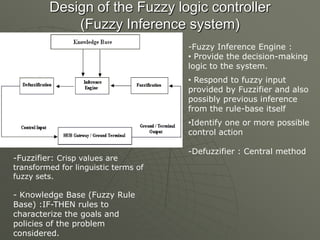
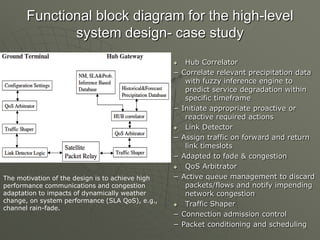
![RED-Fuzzy logic
’üĄ A novel Fuzzy-based packet dropping algorithm
’üĄ In [1] fuzzy inference systems applied to RED
for parameter tuning, based on the inherent
fuzziness in network congestion.
’üĄ Making satellite-IP based network more adaptive
to dynamic weather condition change, e.g.,
channel rain-fade(rain attenuation)
’üĄ In [2] tried to control complexity and non-
linearity inherent of satellite systems by coupling
FL and RED to prevent impending congestion
from happening and to maintain QoS.](https://image.slidesharecdn.com/eabf64d9-e16a-4180-8909-1aa4b48aff60-160702174139/85/Fuzzy-logic-and-Satellite-communication-Systems-19-320.jpg)
![Control problem scenarios [1]:
’üĄ Three different scenarios (control problem)
for weather adaption are considered:
1. Adjustment of the Bandwidth
2. Adjustment of the minimum queue length
qmin
3. Adjustment of the maximum queue length
qmax
’üĄ The current weather conditions, allocated
bandwidth and the queue length are the
input parameters to the above control
problems.](https://image.slidesharecdn.com/eabf64d9-e16a-4180-8909-1aa4b48aff60-160702174139/85/Fuzzy-logic-and-Satellite-communication-Systems-20-320.jpg)
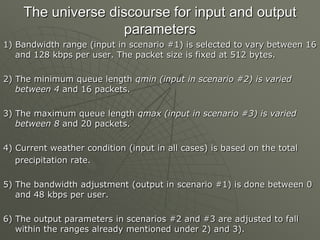
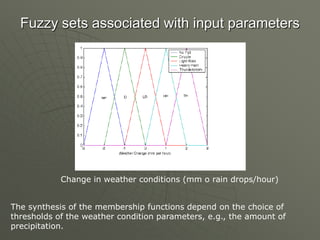
![Scenario#1 (bandwidth ranges )
Bandwidth range (input in scenario #1)
is selected to vary between 16 and
128 kbps per user. The packet size
is fixed at 512 bytes.
Scenario # 1 [Bandwidth Adjustment]
ŌłÆ IF (the current allocated bandwidth is low) AND (weather becomes worse)
THEN {heavily increase the bandwidth to commit the SLA QoS};
ŌłÆ IF (the current allocated bandwidth is medium) AND (weather becomes
worse) THEN {slightly increase bandwidth to commit the SLA QoS};
ŌłÆ IF (the current allocated bandwidth is high) AND (weather becomes worse)
THEN {do not change bandwidth};
ŌĆ”ŌĆ”ŌĆ”..](https://image.slidesharecdn.com/eabf64d9-e16a-4180-8909-1aa4b48aff60-160702174139/85/Fuzzy-logic-and-Satellite-communication-Systems-23-320.jpg)

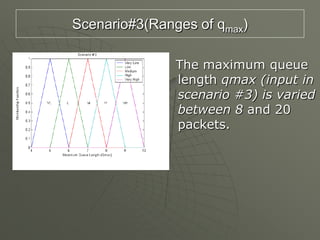
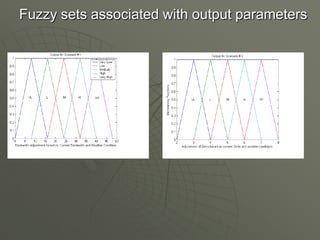
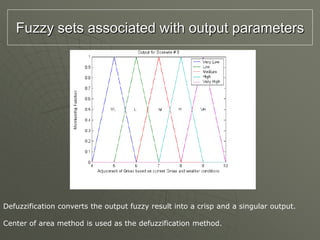
![Control Problem-scenarios [2]
’üĄ eliminating the fixed threshold value, specifically the
qmax value and the drop probability value from RED
and replace with dynamic network state dependant
values calculated by the FI engine.
’üĄ Inference engine keep dynamically calculating qmax
and drop prob. Behaviour based on 2 following
network state inputs:
1. Link Capacity of the channel between the gateway
and the destination (Relay Satellite )
2. The number of dynamic traffic sources accessing the
gateway :
It has a direct impact on changing queue sizes and
provides a direct measure of the future queue state.](https://image.slidesharecdn.com/eabf64d9-e16a-4180-8909-1aa4b48aff60-160702174139/85/Fuzzy-logic-and-Satellite-communication-Systems-28-320.jpg)
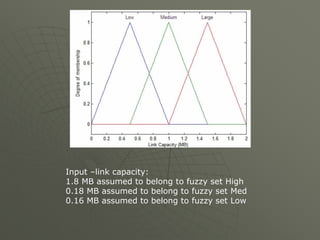
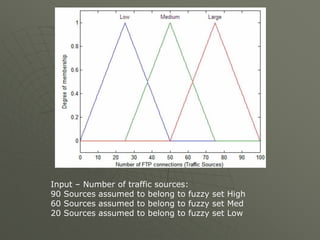
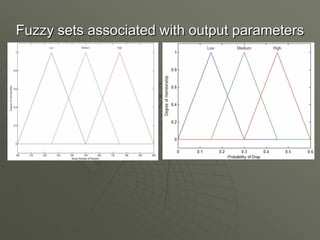
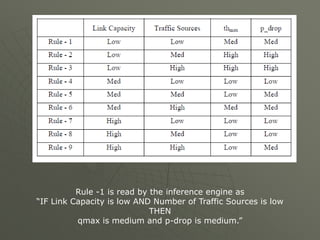
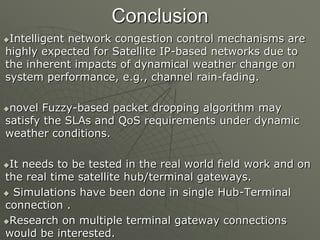
![References:
’üĄ [1]:Adaptive Congestion Control Under dynamic weather condition for
Wireless and Satellite Networks;Hongqing Zeng, Anand Srinivasan, Brian
Cheng, and Changcheng Huang; EION Inc., Carleton University;
ITC2007-PP.92-107
’üĄ [2]:Congestion Control for Adaptive Satellite Communication systems
Using Intelligent Systems;Banupriya Vallamsundar, Jiesheng Zhu,Brian
Cheng; University of Waterloo; Carleton University; Signals, systems and
Electronic, 2007,ISEE07 International Symposium-pp.415-418
’üĄ [3]: Design an active queue management algorithm based on fuzzy logic
decision.; Fan, Y., Ren, F., Lin, C.; Proceedings of IEEE ICCT 2003,
’üĄ [4]: Steady state analysis of the RED gateway: stability, transient
behavior, and parameter setting, H. Ohsaki, M. Murata, and H. Miyahara,
IEICE Transactions on Communications, Vol. E85-B, Jan. 2002](https://image.slidesharecdn.com/eabf64d9-e16a-4180-8909-1aa4b48aff60-160702174139/85/Fuzzy-logic-and-Satellite-communication-Systems-34-320.jpg)
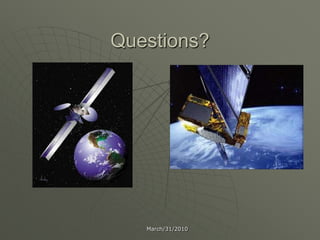
![Back up
’üĄ The term ŌĆ£serviceŌĆØ in the telecommunications:
A service in an IP based environment is defined by International
Telecommunications Unit (ITU) as ŌĆ£a service provided by the service plan to
an end user (e.g., a host [end system] or a network element) and which
utilizes the IP transfer capabilities and associated control and management
functions, for delivery of the user information specified by the service
level agreementsŌĆØ (ITU Recommendations, 2001).
’üĄ The meaning of ŌĆ£qualityŌĆØ is very broad:
In telecommunications it is commonly used in assessing whether the service
satisfies the userŌƤs expectations. However, the evaluation depends on
various criteria related to the party rating the service. Customers assess it
on the basis of a personal impression and in comparison to their
expectations, while an engineer expresses quality in terms of technical
parameters.
This discrepancy may sometimes lead to misunderstandings between the
service provider and the customer.](https://image.slidesharecdn.com/eabf64d9-e16a-4180-8909-1aa4b48aff60-160702174139/85/Fuzzy-logic-and-Satellite-communication-Systems-36-320.jpg)